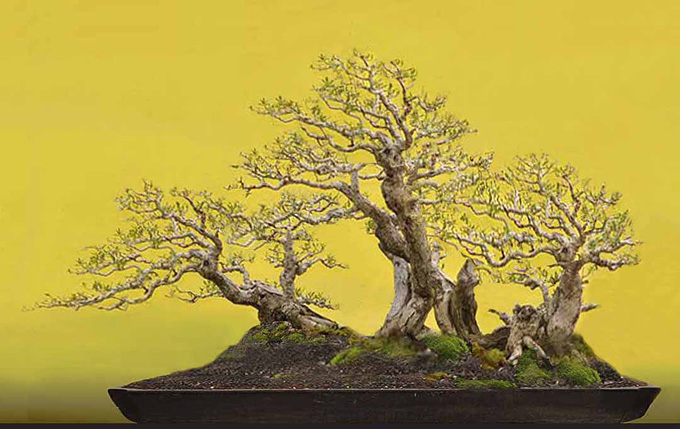 Robert’s simulation of a submission by Nyoman Agus (the original is below).
Robert’s simulation of a submission by Nyoman Agus (the original is below).Getting down to the finer points
So much of what you see and read in bonsai books and elsewhere, just repeats the same old basic principles. Even some of the most experienced teachers seem to fall into this trap. It’s easy to understand, given that bonsai is still fairly young in much of the world and so many of us are still trying to learn those basic principles. But still, it’s a breath of fresh air when someone digs into subtleties that most of us would never think of. This is where Robert Steven comes in. I am repeatedly impressed by Robert’s grasp of, and ability to express, many of the finest points of bonsai. Things that are so easy to overlook unless they are pointed out.
 Nyoman Agus’ submission.
Nyoman Agus’ submission.
Robert’s comments
There are several issues with this raft style bonsai
- A common mistake that is made all over the world, is training deciduous bonsai as though they are coniferous bonsai, with an apically dominant structure; a single line that forms an apical crown. Old deciduous trees are not supposed to have this type of structure; they should be wide open rather than featuring a single line that forms an apex. Only conifers or young deciduous tress do this.
- People tend to consider “front” in bonsai as the viewing angle that show everything clearly and openly; consequently, many bonsai have a flat front without much perspective. All three trunks in this bonsai are positioned in a horizontal straight-line, so there is little perspective in this composition.
- These three trunks are placed the same distance apart with their canopies clearly separated. As a consequence, they lack unity; they all seem to be standing alone, with no distinct focal point.
- From the lines of the trunks, we can be certain that the overall movement is suppose to flow to the left; but the potting position with the middle tree slightly to the left creates a contradiction. The trees seem to flow to the left, but the pot is pointing to the right, so there is a problem of visual balance.
- Last but not least, the pot is a little too deep.
Solution (please see the simulation at the top of the post)
- Re-structure the branching (ramification) by changing the apical dominant form to an open structure with clip-and-grow technique. If we look at all the trunks’ movements, they are all bending to the left. Morphological speaking, there are certainly natural reasons why such features are formed. One logical reason is the wind blowing, so why not to create a wind-swept style bonsai? Pemphis might not be good for a wind-swept style that depicts an existing wind (because we cannot defoliated Pemphis), but we can create a style that is formed by a prevailing wind, but with that wind being still at the moment (for details about concepts and techniques for windswept bonsai, please read my book Vision of My Soul).
- In order to create better perspective, I would suggest changing the front to view slightly from the right. By doing so, we can also correct the distance issue to make the two trees on the right closer.
- Rearranging the individual crowns’ positions and overlapping their foliage improves the overall unity. When you do this on the two trees on the right, the focal point is enhanced and you have better foreground and background views. Another way to improve the perspective is the contour of the soil surface and the green moss placement. Make the right side contour higher to the front with lighter color moss and overlap the contour of the left side with darker moss. This small gap will create an illusion that the left tree is farther back.
- Use a shallower pot and place the trees slightly to the right to create more space on the left. This will enhance the movement and create better visual balance.
General comments
There is more than one way to design any bonsai and my critiques and recommended solutions might not always fit your taste and personal preferences, but I always try to give my opinion based on artistic and horticultural principles.
To understand my concepts better, please read my books Vision of My Soul and Mission of Transformation which are available at Stone Lantern.
Source: Bonsai Bark
0 comments:
Post a Comment